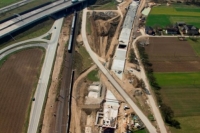Vienna - Salzburg High Performance Railway Line,
Hubertendorf - Blindenmarkt Section
Client: Austrian Railways Infrastructure AG
Development Period: 1997 to 2014
In the course of the development of the railway line Vienna - Salzburg into a high-performance track, the 4.3 km long section between Hubertendorf and Blindenmarkt in the state of Lower Austria was implemented.
Because of the straightening of the line in this section, the new track runs partly at a significant distance from the existing line. Due to the topographic situation and the necessary crossing of the Western Railway Line, 2.2 km of the section have to be lead within a tunnel.
The tunnel was firstly (from east to west) established by means of a cut-and-cover top-down method with a length of 1.7 km. The 380 m long central part (Burgstaller Tunnel) was built using the mining technique (NATM). At the western end, over a length of 120 m, a cut-and-cover bottom-up method was used.
Along the open route, the project includes eight bridges.
BGG Consult attended to this project with regard to geotechnics, geology and hydrogeology since the route selection procedure with public participation.
Based on several subsoil exploration campaigns, geotechnical, geological and hydrogeological expert's reports have been compiled for the construction permission as well as for the tenders of the different contract sections.
During construction, expert's consulting on site, the checking of the detailed project from a geotechnical perspective and the dimensioning of securing measures of construction pits were carried out. Additionally, retaining structures (pile walls) were monitored by means of geodetic measuring points and inclinometers.
Ground Water Exchange Measures:
The bored piles of the tunnel built by the cut-and-cover method entail an obstacle for the natural ground water flow. Without appropriate measures, this can lead to undesirable raise or drawdown occurrences.
Therefore, ground water exchange measures have been a fixed part of the project since the earliest planning phase. For this purpose, the ground water is caught upstream by means of secant gravel pile groups, conducted by culverts through the structure and released downstream back into the aquifer. For the dimensioning of these measures, BGG Consult carried out comprehensive numeric ground water model calculations.
June 2014
